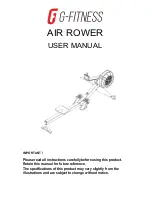
61
Pre-Travel Information
Loading Your RV
For traveling safety, distribute your cargo evenly side-to-side.
Keep the weight on each tire from exceeding one-half of the
GAWR (Gross Axle Weight Rating) for either axle.
During a sudden stop, free-standing furniture or overlooked
items on the counter top or range can become dangerous
projectiles.
• It is important to secure the appliance or furniture tie
down straps (if so equipped).
• Store and secure all loose items inside the RV before
traveling. Check that items such as canned goods, pots
& pans, small appliances, etc. are safely put away.
Weighing Your Tow Vehicle & RV
To confirm that your loaded RV complies with all vehicle, tire
and axle weight ratings, weigh your RV at a public scale. This
will also help you to determine the proper load distribution.
Keep in mind that individual scales will operate differently and
that the area around the scale must allow for weighing each
side of your RV.
• Total Weight
and
Balance
are the two most important
factors when loading your RV.
• ALWAYS verify that your loaded RV is in compliance
with all applicable weight ratings.
• Overloading your RV will void the Limited Base Warranty
and Limited Structural Warranty, and the warranties of
many component part manufacturers.
To weigh your tow vehicle and RV
Read through all the weighing instructions before you begin.
Your RV must be weighed fully loaded (that is with food, cloth-
ing, fuel, water, propane, supplies, etc.).
1. Weigh the RV while unhitched from your tow vehicle
to obtain your
Gross Vehicle Weight
(GVW).
◦
The weight of your RV MUST be
less than,
or equal to
the GVWR for safe operation.
◦
If the weight of your RV is
greater
than the GVWR,
remove contents until your weight is in compliance
with the listed ratings.
DO NOT EXCEED YOUR
GVWR! This means you
should weigh your RV as
loaded for your normal
travel to determine the
actual weight.
If you exceed the GVWR,
you MUST remove items
from the RV, or drain
liquids, then re-weigh the
RV to ensure you have
achieved a safe weight.
DO NOT travel with full
grey/black holding tanks.
This not only wastes gas
but, depending upon the
location of the grey or black
holding tanks, can affect
handling characteristics.
Never load the RV in excess
of the GAWR for either axle.
Overloading the RV may
result in adverse handling
characteristics and
damage to the chassis.
Only store items in the
areas designated for
storage. DO NOT store
anything in the areas
reserved for the furnace,
water heater, converter, or
electrical panels, etc.
WARNING
WARNING
WARNING
Summary of Contents for Momentum
Page 1: ...OWNER S MANUAL ...
Page 2: ......
Page 4: ...This page is intentionally blank ...
Page 6: ...This page is intentionally blank ...
Page 31: ...29 This page is intentionally blank ...
Page 36: ...34 This page is intentionally blank ...
Page 86: ...84 This page is intentionally blank ...
Page 87: ...85 This page is intentionally blank ...
Page 90: ...88 This page is intentionally blank ...
Page 106: ...104 This page is intentionally blank ...
Page 122: ...120 This page is intentionally blank ...
Page 123: ...121 Nautilus P1 Manual Nautilus P1 Manual ...
Page 124: ...122 Nautilus P1 Manual ...
Page 125: ...123 Nautilus P1 Manual ...
Page 126: ...124 Nautilus P1 Manual ...
Page 127: ...125 Nautilus P1 Manual ...
Page 128: ...126 Nautilus P1 Manual ...
Page 129: ...127 Nautilus P1 Manual ...
Page 130: ...128 Nautilus P1 Manual ...
Page 131: ...129 Nautilus P1 Manual ...
Page 132: ...130 Nautilus P1 Manual ...
Page 133: ...131 Nautilus P1 Manual ...
Page 134: ...132 Nautilus P1 Manual ...
Page 135: ...133 Nautilus P1 Manual ...
Page 136: ...134 Nautilus P1 Manual ...
Page 137: ...135 Nautilus P1 Manual ...
Page 138: ...136 This page is intentionally blank ...
Page 216: ...214 Customer Notes ...
Page 217: ...215 Customer Notes ...
Page 218: ...216 Maintenance Record Maintenance Record Date Work Performed Next Service ...
Page 219: ......
















































